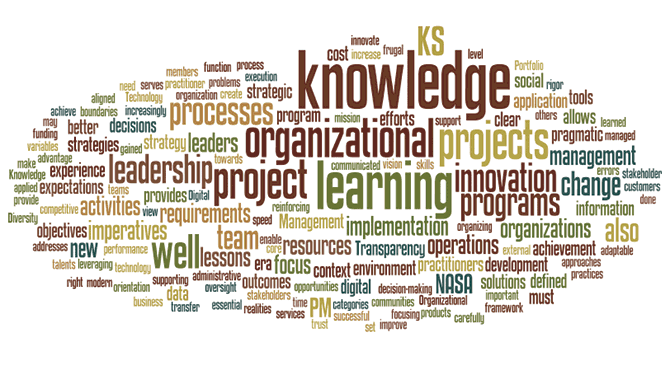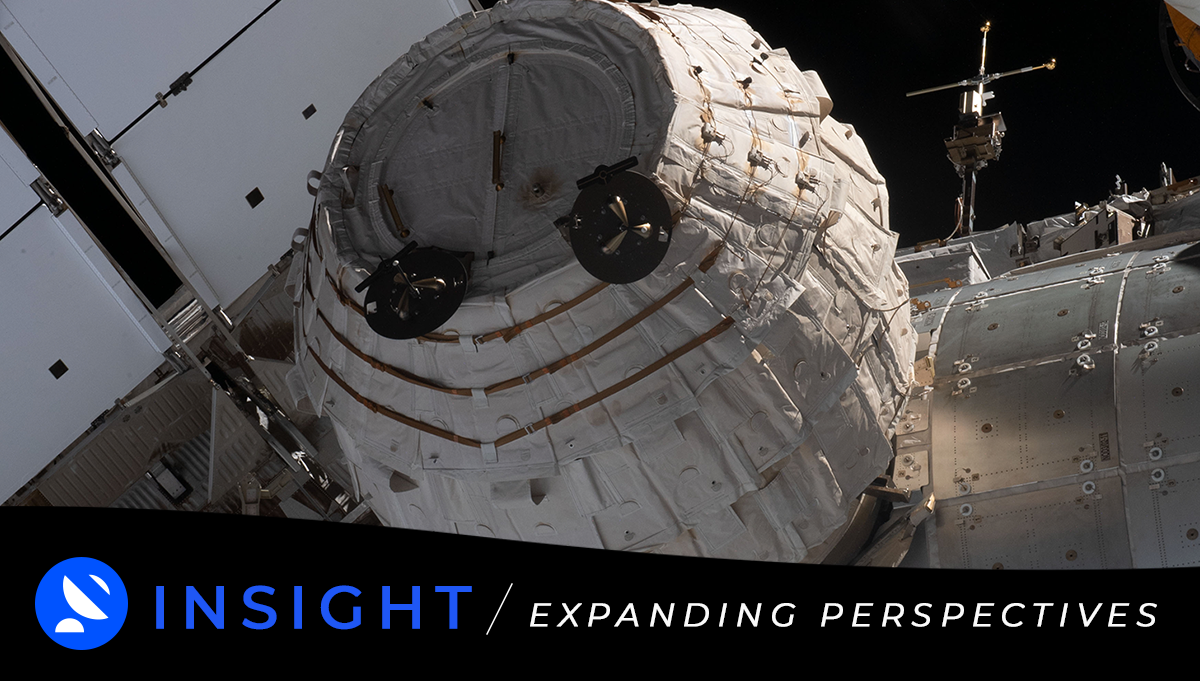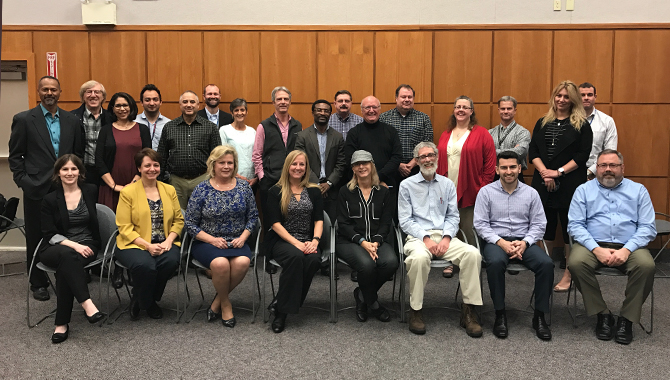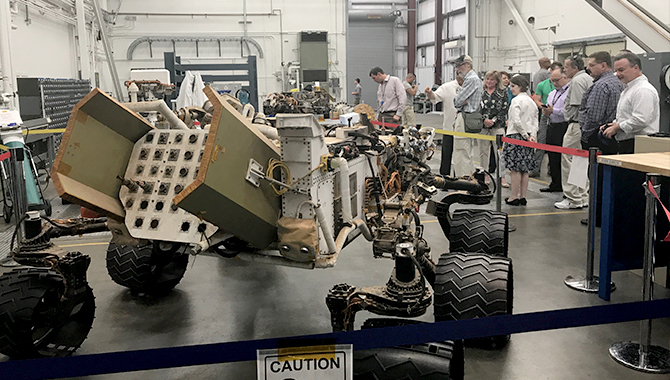
NASA recently embarked on plans for an agency-wide assessment that could lead to a more efficient operating model for current and future missions.
A NASA-appointed Mission Support Council responsible for implementing the comprehensive review established Business Services Assessment (BSA) “deep dive” teams to assess the health of each business function such as procurement, business capability, program/project planning and technical capability. The teams were also chartered to identify opportunities for optimization and develop risk-informed recommendations.
For at least one of the teams, the assessment revealed opportunities to leverage knowledge management (KM) to optimize volume, time and leadership. The Procurement BSA “deep dive” team’s outcomes and recommendations included knowledge management activities that would enhance procurement processes and practices across the agency. As the team listened to stakeholders’ feedback and analyzed NASA procurement operations, workforce, governance and policy, benchmarking and compliance, and procurement efficiency initiatives, it became clear that improved knowledge sharing could help drive efficiencies across all phases of the acquisition cycle. Barbara Trujillo, NASA Procurement’s Knowledge Services lead, took action to facilitate collaboration and knowledge sharing by standing up a team and organizing meetings and subgroups to outline and implement plans for improvements, which sparked momentum around the outcomes and recommendations.
Procurement data analysis
At the outset, the BSA procurement core team analyzed the data and concluded that although current processes, practices and structure are working and receive high ratings from NASA customers, the agency could enable more efficient approaches in procurement operations. The analysis identified the following areas that need improvement across the agency:
- Challenges in defining requirements
- Difficulties and inconsistencies in measuring processes
- Extended and inconsistent results for procurement lead times
- Extended periods of time spent conducting source evaluation boards (SEB)
Using this information, the BSA core team rated the overall health of various procurement operations and developed optimization opportunities. The team’s findings indicated that, if adopted, the optimization opportunities would result in:
- Reduction of procurement lead times
- Reduction in staff required to support the acquisition process
- Reduction in procurement costs through more affordable contracts
- Educated customers who are able to better define their requirements
- Increased compliance and quality of products, thereby reducing agency risk
Challenges
Based on the observations and findings of the BSA core team, the Mission Support Council noted the following significant challenges:
- Long lead times
- Underutilized flexibilities
- Inconsistent thresholds
- Inadequate collaboration
- Redundant contract vehicles
- Leadership commitment
- Lack of workforce flexibility
Decisions
The Mission Support Council identified knowledge management opportunities throughout its decisions related to the procurement assessment.
- Optimizing Volume: Reduce volume of activities, including the number of contracts, tasks and activities, and the corresponding work being performed with these activities.
- Decision 1: (Strategic Sourcing). Expand the use of strategic sourcing across NASA. Establish a searchable repository of available contracts. Strengthen policies requiring NASA centers to use strategic sourcing contracts. Implement a process for centers to review existing contracts prior to establishing a new contract.
- Decision 2: (Acquisition Assignments). Initiate a multi-year phased approach to strategically assign specific centers the responsibilities to conduct and manage acquisitions and acquisition activities on behalf of the agency. NASA centers will leverage assigned centers in select areas to attain supplies or services rather than awarding their own contracts.
- Decision 3: (Contract Administration). Work with NASA centers and the NASA Chief Financial Officer (CFO) to develop more effective guidance for establishing new task orders on contracts, strengthen policies to enable timelier funding of contracts, and investigate the ability to raise the level of obligations on contracts while sustaining lower level cost insight to enhance management insight and reduce transactional and administrative costs.
- Optimizing Time: Reduce the lead times in the process and enable consistent policy and guidance to ensure more efficient practices for NASA.
- Decision 4: (Evaluation). Establish a community of practice across NASA centers to share lessons learned, identify best practices, establish sample templates, and provide more expert guidance to SEB chairs and members. Centralize management of cost/price analysts to support pricing requirements across NASA centers.
- Decision 5: (Policy and Guidance). Develop strong policy guidance to enable more timely selections of new contracts, including appropriate use of alternative source selection methodologies and true discriminator evaluation factors. Identify and establish streamlined processes required to reduce procurement lead times.
- Optimizing Leadership: Strengthen knowledge management, ensure effective project management systems, and enable strong leadership and
- Decision 6: (KM). Establish a knowledge management framework that will enable strong and effective knowledge capture and sharing capabilities to improve cross-center collaboration.
- Decision 7: (Project Management). Integrate strong project management principles into the acquisition process to enable more discipline and reduce associated lead times.
- Decision 8: (Leadership). NASA senior executives and leaders will ensure strong and effective professional capabilities to support all of these BSA decisions and help establish a model of more interdependence across NASA centers to ensure more effective and efficient operations.
Implementation
Decision 6 specifically addresses KM, but from a “KM” lens, opportunities are evident across the decisions and recommendations. A KM strategy is a foundational element to achieve all the decisions. As indicated in each of the decisions above, the success of the Procurement BSA implementation will require an integrated KM strategy.
In order to take action and implement Decision 6 and KM recommendations woven throughout the other decisions, Trujillo drew upon an existing network of procurement POCs at each of the NASA centers. With the help of Moses Adoko, Goddard’s Deputy Chief Knowledge Officer (CKO), and Jennifer Stevens, Marshall’s Chief Knowledge Integrator (CKI), Trujillo hosted an off-site at Marshall where 20 people came together in March 2016 to review the council’s decisions and identify how to implement necessary changes to very specific improvement activities designed to address the following key areas:
- Enhancing procurement training for all those involved with the acquisition cycle (procurement, pricing, technical evaluation and SEB members)
- Virtualizing capabilities
- Leveraging automation
- Establishing a repository accessible across the agency (policies, procedures, lessons learned, samples/templates, handbooks, etc.)
- Conducting paperless contracting to include contracts, document reviews and electronic proposals
Trujillo and the team left the meeting armed with a clearer understanding of the improvement opportunities they would embark upon to accomplish their overall “deep dive” objectives. They identified subgroups to work the different activities, and the teams have been meeting weekly since March to plan and implement changes.
One important activity is the refresh and enhancement of the NASA Office of Procurement website where people can find policies, procedures, guides, handbooks, forms and templates. Subgroup members are talking with the Office of the Chief Information Officer (OCIO) to assess options for improvement, necessary resources, and layout and design changes that could help users interact more effectively to find the procurement assistance they need. Another subgroup is looking at technical training, paperless contracting, virtualization, content management, and lessons learned findability.
An effort by the entire NASA acquisition team will be needed to support implementation. Successful implementation will result in a reduction in the number of procurement transactions, contracts, task orders and incremental funding actions as well as the addition of new policies, processes and strategic sourcing.
Procurement Decision Implementation Benefits to NASA. Image Credit: NASAThe implementation schedule continues through 2017. Anyone in the NASA Knowledge Community interested in participating is always welcome!
For more information on the procurement decision highlights, please visit https://nbat.hq.nasa.gov/bsa/decisions (NASA internal).









